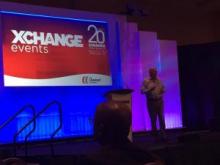Former CompuCom CEO: Survival Depends On Constant Change
Submitted by Lindsey O'Donnell on

In 2004, CompuCom was a struggling hardware company with services making up a mere 16 percent of its revenue.
Fast forward to 2012, and the company had switched to a services company with over 55 percent of its business from services and had grown its revenue from $1.4 billion to $2.3 billion.
CompuCom Chairman and Former CEO Jim Dixon took the stage, Monday, at XChange 2015, hosted by CRN's publisher The Channel Company, to discuss how he helped turn around the struggling company through ramping up recurring revenue, guided CompuCom from a publicly-traded entity to a privately held one, and grew the business by a billion dollars in eight years.
The main suggestion Dixon had for solution providers dealing with massive industry changes? Embrace and capitalize on changing business models to keep up with new trends.
"CompuCom would have continued to fail if we didn't change," he stressed. "Survival depends on constantly adjusting, changing, updating and improving your model, or the business eventually will go down."
When Dixon returned to CompuCom as the company's CEO in 2004, the company was struggling to make money as a hardware company. There was a lack of focus on services, said Dixon, while hardware sales had single-digit gross margins and data center projects brought in very little revenue.
"The change at CompuCom started with an internal assessment," said Dixon. "We looked at strengths and weaknesses, where the industry is going, and where we wanted to go in the future in the next few years."
Dixon's vision? To transition CompuCom into an IT outsourcing company with a focus on the end user through building recurring revenue, long-term contracts, and pushing services from the company's 16 percent in 2004 to 50 percent, in five years.
In order to do so, Dixon had a multi-part plan. He said he targeted a financial model that involved staying away from facilities or data center investments. In addition, Dixon made steps to increase the company's one call center by adding an off-shore call center, which he said was "one of the better moves I ever made."
The company made its first major investment during the turnaround in 2007, acquiring GE IT Solutions to add $180 million of service revenue to its portfolio as well as an expanded geographical presence.






